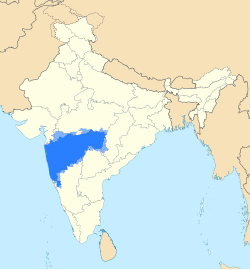
Back Marathi Afrikaans मराठी भाषा ANP اللغة المراثية Arabic مراتى ARZ মাৰাঠী ভাষা Assamese Idioma marathi AST मराठी AWA Marathi dili Azerbaijani مراتی دیلی AZB Маратһи теле Bashkir
| Marathi | |
|---|---|
| Marāṭhī | |
| मराठी, 𑘦𑘨𑘰𑘙𑘲, مراٹھی, മറാഠി, மராத்தி, ಮರಾಠಿ | |
The word "Marāṭhī" in Devanagari & Modi script | |
| Pronunciation | Marathi: [məˈɾaːʈʰiː] ⓘ English: /məˈrɑːti/ |
| Native to | India |
| Region | South and Western India
Southern and Eastern Pakistan
|
| Ethnicity | Marathi |
| Speakers | L1: 83 million (2011)[4] L2: 16 million (2011)[4] |
Early form | |
Standard forms |
|
| Dialects |
|
| |
| Indian Signing System | |
| Official status | |
Official language in | India |
Recognised minority language in | |
| Regulated by | Ministry of Marathi Language and various other institutions |
| Language codes | |
| ISO 639-1 | mr |
| ISO 639-2 | mar |
| ISO 639-3 | Either:mar – Modern Marathiomr – Old Marathi |
omr Old Marathi | |
| Glottolog | mara1378 Modern Marathioldm1244 Old Marathi |
| Linguasphere | 59-AAF-o |
 regions where Marathi is the language of the majority or plurality regions where Marathi is the language of a significant minority | |
 Map of Marathi language in India (district-wise). Darker shades imply a greater percentage of native speakers of Marathi in each district. | |
Marathi (/məˈrɑːti/;[15] मराठी, Marāṭhī, pronounced [məˈɾaːʈʰiː] ⓘ) is a classical Indo-Aryan language predominantly spoken by Marathi people in the Indian state of Maharashtra and is also spoken in other states like in Goa, Karnataka, Tamil Nadu, Telangana, Gujarat, Kerala, Madhya Pradesh, Chhattisgarh, and the territory of Dadra and Nagar Haveli and Daman and Diu[1][2][16][17] It is the official language of Maharashtra, and an additional official language in the state of Goa, where it is used for replies, when requests are received in Marathi.
It is one of the 22 scheduled languages of India, with 83 million speakers as of 2011. Marathi ranks 13th in the list of languages with most native speakers in the world. Marathi has the third largest number of native speakers in India, after Hindustani and Bengali.[18] Marathi has some of the oldest literature of all modern Indian languages.[19] The major dialects of Marathi are Standard Marathi and the Varhadi Marathi.[5] Marathi was designated as a classical language by the Government of India in October 2024.[20]
Marathi distinguishes inclusive and exclusive forms of 'we' and possesses three genders: masculine, feminine, and neuter. Its phonology contrasts apico-alveolar with alveopalatal affricates and alveolar with retroflex laterals ([l] and [ɭ] (Marathi letters ल and ळ respectively).[21]
- ^ a b [1] Archived 7 November 2012 at the Wayback Machine
- ^ a b "C-16 Population By Mother Tongue". censusindia.gov.in. Retrieved 3 April 2021.
- ^ Indian Linguistics. Linguistic Society of India. 2008. p. 161.
- ^ a b Modern Marathi at Ethnologue (27th ed., 2024)

Old Marathi at Ethnologue (27th ed., 2024)
- ^ a b c Dhoṅgaḍe, Rameśa; Wali, Kashi (2009). "Marathi". London Oriental and African Language Library. 13. John Benjamins Publishing Company: 101, 139. ISBN 9789027238139.
- ^ "झाडी बोली (मराठी भाषेतील सौंदर्यस्थळे) | मिसळपाव". www.misalpav.com. Retrieved 15 March 2020.
- ^ "Marathi | South Asian Languages and Civilizations". salc.uchicago.edu. Retrieved 15 March 2020.
- ^ Ghatage.
- ^ "Know Your City: The Modi script, using which Maratha empire would conduct business". 5 February 2022.
- ^ "'Other' Modi wave: How 700-year Marathi script is making a comeback". The Times of India. 7 July 2019.
- ^ "Goykanadi script".
- ^ "Marathi language, alphabet and pronunciation".
- ^ "The Goa, Daman and Diu Official Language Act, 1987" (PDF). indiacode.nic.in. Retrieved 12 November 2022.
- ^ Cite error: The named reference
goawas invoked but never defined (see the help page). - ^ Laurie Bauer, 2007, The Linguistics Student's Handbook, Edinburgh
- ^ Lal, M. B. (2008). N. E. R. Exam. Upkar Prakashan. ISBN 978-81-7482-464-6.
- ^ Kaminsky, Arnold P.; Roger, D. Long PH D. (23 September 2011). India Today: An Encyclopedia of Life in the Republic [2 volumes]. Bloomsbury Publishing USA. ISBN 978-0-313-37463-0.
- ^ "Abstract of Language Strength in India: 2011 Census" (PDF). Censusindia.gov.in.
- ^ "arts, South Asian". Encyclopædia Britannica. Encyclopædia Britannica 2007 Ultimate Reference Suite.
- ^ Cite error: The named reference
IT_Oct2024was invoked but never defined (see the help page). - ^ Dhongde & Wali 2009, pp. 11–15.